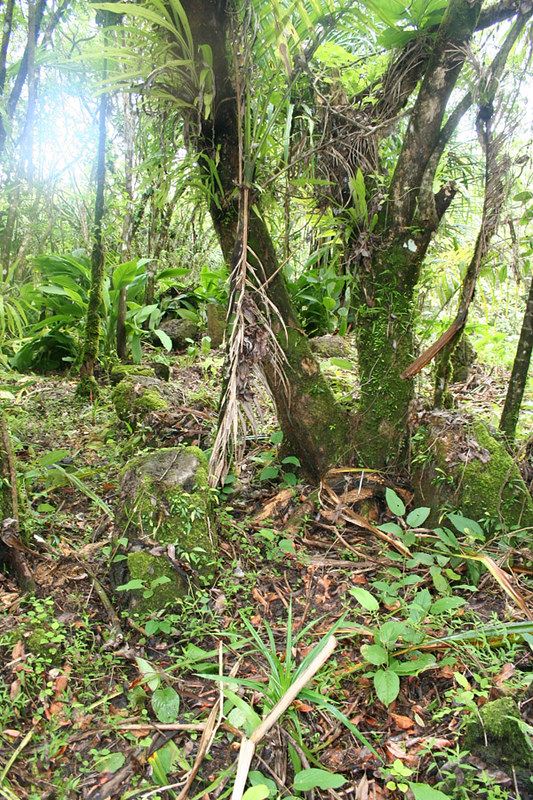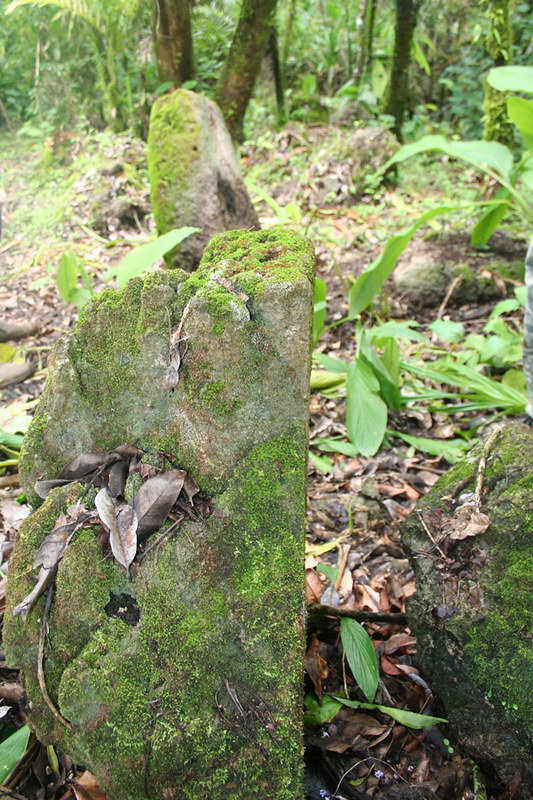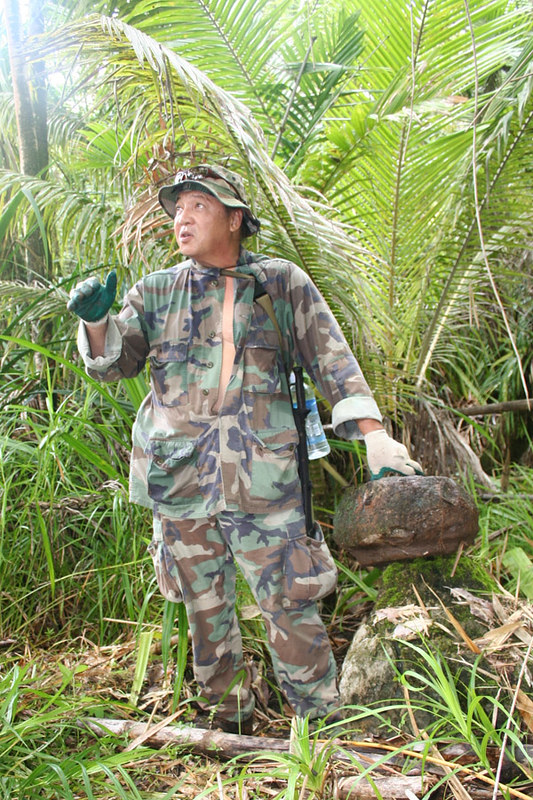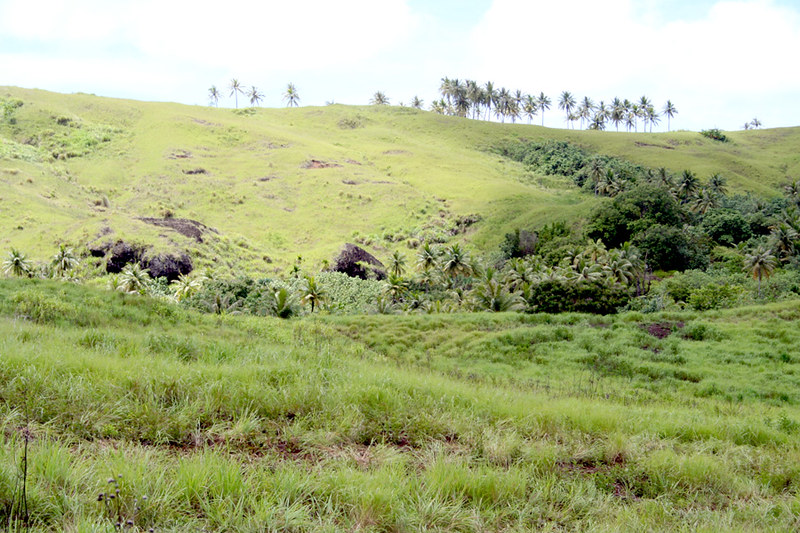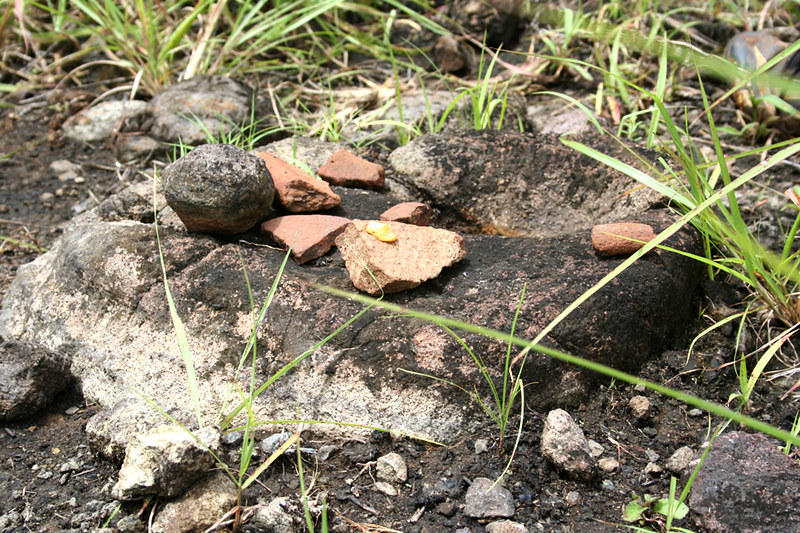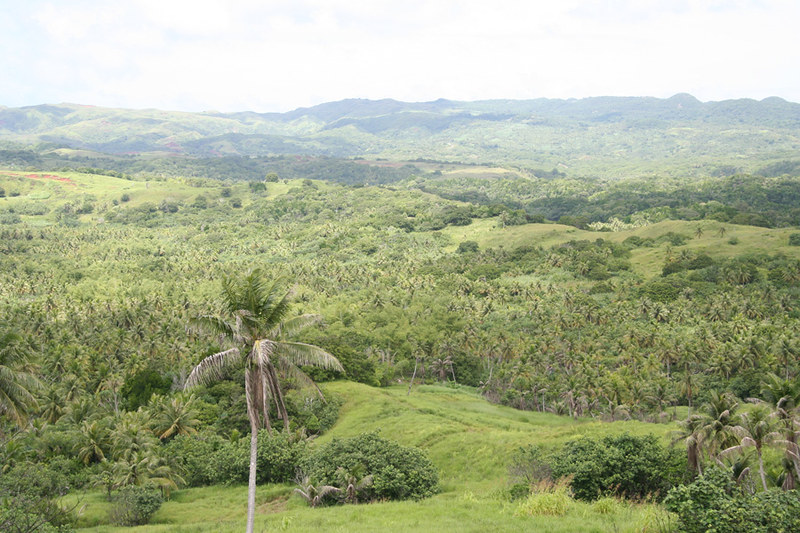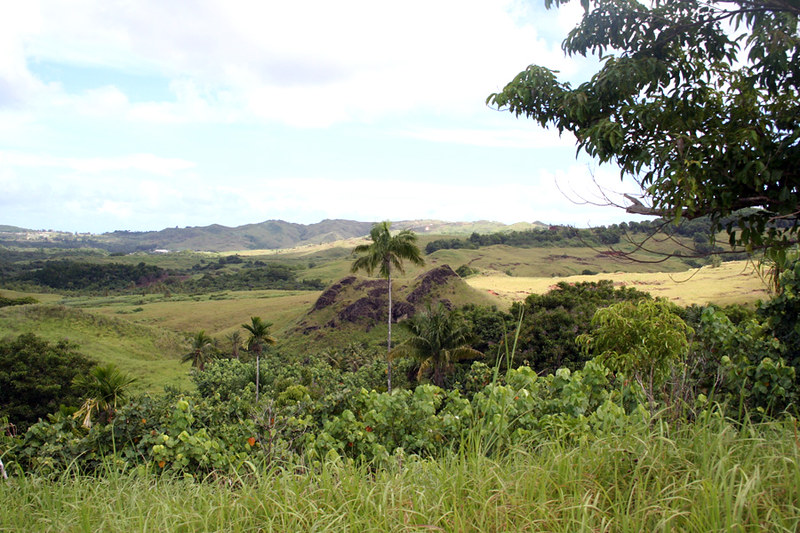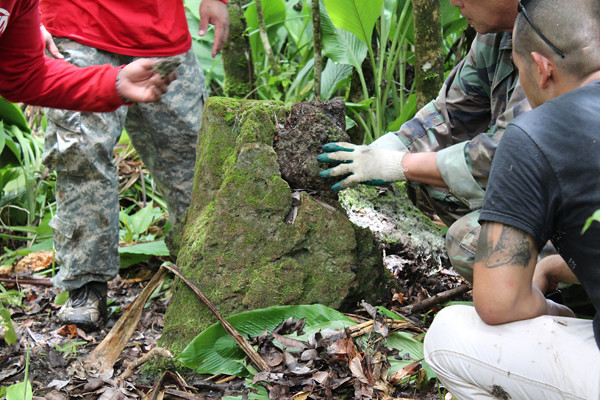Few things speak more loudly about ancient cultures than the tangible elements they leave behind–buildings, tools, drawings, skeletal remains–physical reminders that a people once lived and breathed and died in a particular place within a specific historical context. These elements take on great meaning when the ancient culture is an ancestral one, rooted in the past but with descendants who exist in the present. For modern day descendants, often times showing these tangible links to the past can be empowering and very useful to demonstrate unity, identity, distinctiveness and relevance in a global world.
There are numerous ways for people to demonstrate links to their ancestors. Here in the Pacific Islands, the quadrennial Festival of the Pacific Arts, or FESTPAC, is just one of many celebrations of different arts and cultures that occur throughout the region. Sometimes, activities and stories that recreate or generate interest in traditional methods or ways of life can also show how the past is still important in todayʼs world. The recent revival in Micronesian seafaring and navigation and the construction of traditional canoes, for example, represent a successful effort to reconnect and relearn knowledge that at one time had been lost or forgotten for the people of the Marianas.
Connections with the past can also be pointed out in highly politicized arenas–for example, calls for political sovereignty often refer to ancestors and their connectedness to the land. In this way, the ancient past is emphasized as vital to understandings of cultural–and political–identity. Whether reciting a genealogical chant or engaging in dance and song, participating in a life-marking ritual, or using traditional medicines, in many cases these performances involve active connections with ancestors, ancient traditions and knowledge.
Connections to land, buildings or other structures can also provide people with important links to the past. Burial grounds, religious sites, monuments and historical landmarks point to spaces that resonate with people with a common culture and history. They can evoke powerful emotions and feelings, promote a sense of community and affirm cultural identity.
In Guam, there are many places of historic value or interest. All over the island are visible remnants of Guamʼs history in World War II–from guns, to pillboxes to the extensive cave system bored in the hillside of Hagåtña. There are buildings from the Spanish era — Fort Soledad in Humåtak, Fort Santa Agueda in Hagåtña, the old administrative buildings next to the Plaza de España, and arched stone bridges in Hagåtña and Hågat. Even the ancient Chamorros left behind structures that remind us of the people that lived in the Marianas long before Europeans began traveling around the world. Rock shelters, modified caves and latte sites show where ancient Chamorros lived, fished, gathered and processed materials important for their daily lives. These sites may not be well understood or visually spectacular sights to behold, but the historic places of ancient Chamorro society are important cultural resources and part of the unique heritage of the Chamorro people.
The power of place
To learn and discover more about Guamʼs ancient past, many have looked to archeology, the field of anthropology that inquires about the artifacts of past societies in order to draw insights into the shared customs, norms and values of ancient peoples. Archeologists study artifacts, the material products of former societies; they excavate and sort through ancient trash piles, or middens, to find clues about how people lived. Pieces of pottery, tools, weapons and sometimes even jewelry are methodically analyzed in laboratory settings to carefully glean information from these broken fragments. Because written historic records of Chamorro culture only date to the first observations of early European explorers, archeologists often work with historians to piece together descriptions of ancient Chamorro society, beliefs and activities.
Compared with other islands in Micronesia, archeological research in Guam and the Northern Mariana Islands is quite extensive. Visitors since the early 1800s have marveled at the architecture of latte stones, the distinctive pillars of limestone or volcanic rock characterized by an upright base topped with a semi-hemispherical capstone. Latte stones are found throughout the Marianas, but it was not until the 20th century that more systematic archeological investigations into Guamʼs ancient past were conducted. Many of the places selected for study were known to contain latte structures. Other sites did not have latte but did have evidence of human habitation — skeletal remains, pottery sherds, mortar stones and tools, perhaps.
These ancient sites were not always treated with curiosity or even respect. In fact, for many Chamorros, latte sites were feared and avoided because of strong beliefs in the spirits that inhabited the thick jungles and caves around Guam. But as more archeological research has been done in the Marianas a picture emerges about the lifeways of the ancient Chamorros. People are able to see these places as valuable sources of cultural knowledge, historic information, and meaningful inspiration.
Guamʼs ancient sites are particularly compelling. Archeological studies confirm that the people of the Marianas shared a cultural system unique from other peoples of Micronesia. Indeed the Marianas are one of the longest inhabited islands in the Pacific region, with settlements dating as far back as 3,800 years ago. Artifacts recovered from Guamʼs ancient sites reveal a population that survived various environmental challenges and that showed ingenuity in finding and procuring resources from their surroundings. These sites tell us how the Chamorros and their ancestors lived, worked, interacted with each other and buried their dead. They also provide insight into the larger story of ancient societies and human experience.
Ancient sites are part of our heritage. They are the legacy we have inherited from our ancestors and what we pass on to future generations. They have value and meaning and are considered worthy of preservation and conservation. The value and meaning of heritage sites, however, are socially constructed and influenced by historical and socio-political forces.
For example, as mentioned earlier, latte sites may not have been sacred in the sense of places for religious worship — they may have been purely functional as building foundations. But over time, no longer in use, they were imbued with different meanings — mysterious, dangerous. Today, many Chamorros consider latte sites sacred spaces and treat them and the structures contained within them with a kind of reverence and awe. Latte stones have become symbols of strength and cultural identity. Even if one cannot see the sacredness in the symbol of the latte stone, it is undeniable that it has become THE symbol of the Marianas, and represents the unique identity of the Chamorro people today.
Hassoʼ: To remember
In any kind of effort to reach back to the past, there is the specific act of remembering. In Chamorro, the word meaning “to remember” is hassoʼ. Hassoʼ also means to think, to imagine or to realize. Clearly when discussing ancient sites, there is no one around who has actual firsthand knowledge of what meanings a site may have had for the original builders or inhabitants. However, as descendants and inheritors, there can be memories of visiting certain places, or of being told stories about particular locations or structures. There may be multiple meanings and interpretations and feelings regarding different sites. The sites may become significant to people because they represent something that goes beyond memory alone — they spark imagination and speak to a desire to know the past. As inheritors, the collective meanings and values placed on particular sites bind people as a community with a shared identity.
Appreciating heritage sites and protecting them, however, are not limited to one segment of a society. The preservation of heritage concerns us all. It is not automatic. Heritage sites are irreplaceable, but certainly destructible. The preservation of historic sites, therefore, requires a collective community effort that begins with awareness.
We rely on our past to give us a sense of who we are and how we identify ourselves to others around us. Likewise, communities need the past to give them a sense of identity which leads to responsibility for the care and concern for the tangible and intangible elements of the past that can be passed on to future generations. How places are cared for and respected reflects how much value a community places on them. The preservation of historic places plays a role in the social well-being of a community, especially a multi-ethnic community such as Guamʼs. We all become stakeholders and beneficiaries of historic and cultural preservation.
In May 2011, the Guampedia staff had a chance to visit some of the caves at the US Fish and Wildlife Refuge at Ritidian. The caves have some of the most interesting examples of ancient Chamorro pictographs found on island. Depictions of animals, human figures, handprints, and even whatʼs believed to be a Chamorro calendar, are painted on the walls. Chad Filipiak, a teacher at Harvest Christian Academy, was producing a 360-degree spherical panorama (or simply, a 360 shoot) and was interested in doing one of Ritidian. A 360 shoot is a photography technique whereby a series of images are shot and with the use of the appropriate software, a composite image is stitched together. The resulting image captures a panoramic space which allows a viewer to see a place or an object from various angles. A good 360 shoot can give a viewer the feeling he or she is right there in the photograph, able to look all around and see objects or other features behind them, or even up in the sky above. With local professional videographer/photographer Burt Sardoma, the Guampedia team was able to document their visit to the site and produce some stunning images of the caves and the pictographs.
Hassoʼ: Chamorro Heritage Sites Project
While at the caves, however, it was brought to our attention that the Fish and Wildlife Service had to impose stricter limits restricting access to the caves due to destruction caused by vandals. In addition, some of the cave openings were draped with special nets to try and control insects that were also causing damage to the cave walls. The initial excitement of being able to see the pictographs and visit a site that was historically and culturally important for the Chamorro people was tempered by the realization that Ritidian would be yet another site few people would ever be able to see. More disheartening was the fact that the forces of nature were not only causing deterioration of the site, but the actions of a careless few were equally, if not even more destructive.
Clearly, natural hazards such as typhoons, earthquakes, floods, tsunamis, landslides and wildfires, as well as animal activity or plant overgrowth, all potentially pose threats to Guamʼs heritage sites. However, human activity and development pose the biggest challenges to restoration and protection of cultural resources. Although many historic places on Guam have withstood the test of time, endured countless typhoons and earthquakes, and even survived the bombing of World War II, they are not indestructible; indeed, the fragility of some heritage sites, such as Ritidian, demonstrates the urgency to protect the cultural resources on Guam.
There are other factors that heighten the sense of immediacy to work toward the protection of Guamʼs heritage sites, including the impending military buildup and urban development, for example, slated for the next few years; Guamʼs continued exposure to natural hazards; and the need for more public support and education.
The proposal by the US Department of Defense to use the area known as Pagat, which is listed on the Guam and National Registers of Historic Places, as a site for a firing range to train US Marines has generated heated debate over issues of accommodating military activities while protecting one of Guamʼs most significant heritage sites. The very public effort of local residents to remove Pagat from the militaryʼs list of sites considered for the firing range, as well as the militaryʼs plans to mitigate the potential loss of cultural resources, points to both sidesʼ recognition of the area as being culturally significant. But it was the effort to educate the larger public about Pagatʼs history that revealed the deep-seated desires of members of our community to protect this area at extraordinary cost and pointed out the need for broader and more creative ways to educate people about these unique places around our island.
One way to encourage and heighten awareness of Guamʼs heritage sites is through interpretation. Interpretation based on different sources of information–archeological, historical, anthropological, cultural, etc.– can be used as a tool to help audiences understand and to care about (and care for) our islandʼs heritage sites. Latte sites, World War II memorials and other historic landscapes have value in that they help explain the past and provide insight into the history and the unique identity of the Chamorro people. There should also be room to consider the range of interpretations and perspectives offered by the islandʼs diverse cultural groups, thus providing for an inclusive heritage for all of Guamʼs people. Increased awareness will foster appreciation and knowledge among residents and visitors to our community to become engaged in protecting and preserving Guamʼs cultural resources for the betterment of our island and for future generations.
Another way to encourage awareness of heritage sites is to give people access to places and information. Many of Guamʼs ancient sites, however, are located on lands that are not accessible to the general public, either because they are on private property or within military bases, or are situated on terrain difficult to reach by foot or other physical means.
The challenge we face, then, is: how could people of Guam or those interested in ancient Chamorro culture be able to see these sites when they no longer become accessible? How could people be taught the importance of cultural preservation — and respect–especially of heritage sites? What could this project offer by way of increasing knowledge of Guamʼs heritage sites so as to protect these sites from destruction or desecration by both manmade and natural forces?
The Hassoʼ: Chamorro Heritage Sites Project emerged from the idea of creating a feature on Guampedia that would showcase different ancient sites on Guam. The purpose of the project was to promote awareness about the sites and make them accessible–digitally and visually–for audiences on Guam and around the world. In addition, the project would be used to emphasize the importance of cultural and historic preservation on Guam. A video would be produced with footage of the sites and interviews with people in the Guam community speaking about issues of historic preservation and the protection of heritage sites for future generations.
Five ancient sites were selected for the project, including Pagat (along the northeastern coast,) Cetti (on the southwestern coast), Pulantat, Yona and Babulao, Talofofo (in the interior), and Haputo (on the northwestern coast). Each of these places are regarded as having significant cultural resources. They are all sites of ancient Chamorro villages, and contain a variety of material artifacts including latte sets and other remains of ancient society. Some sites are more difficult to access than others, either because of the thick jungle growth or because they lie on private property or military installations and have restricted or limited access.
Archeological reports were reviewed to gather information about each site, including history of habitation, land utilization or other features unique or significant to the area. Arrangements for site visits and documentation were made largely through personal and professional connections.
Whenever possible with each site, individuals with knowledge of the area were brought as consultants and guides. These individuals were either professionals or property owners who could provide context and insight into the history of the area visited. Light clearing of sites to remove overgrowth or plant debris was done to make some features like latte stones or lusong easier to film or photograph. All sites were treated respectfully by Guampedia staff and consultants.
The next phase of the project is to complete interviews of historians, experts in historic preservation and cultural resource management, and various members of the Guam community who are interested in helping bring awareness for preserving Guamʼs ancient sites. The resulting video and accompanying feature on the Guampedia.com website will demonstrate that:
- Heritage sites can be an important educational resource. Residents and visitors to Guam can learn much about the ancient past of the people of the Mariana Islands because heritage sites help bring the past to the present. Heritage sites also demonstrate links between history, culture and the natural environment. Raising awareness of the heritage sites around our island can spark interest in people to learn more about the unique culture and history of Guam. In addition, individuals can learn how to treat ancient sites, as well as monuments and other public places that are historically significant, with care and respect. They can see that cultural heritage is fragile and needs to be protected, and recognize natural and manmade threats to cultural heritage, including pollution, urban development, vandalism and neglect.
- Partnerships can be formed in the community to support historic preservation. By working with members in the business community, private organizations, nonprofits and government agencies, there are many ways relationships can be formed to revitalize interest and support for preserving Guamʼs ancient sites. Good legislation is needed to protect endangered sites. Cooperation between site managers, educators and community leaders can help mitigate the problems caused by activities or growth that damage or harm historic sites. Preservation requires community effort, specialized equipment and support that private companies can provide to offset costs.
- Young people can participate in historic preservation and understand their role and responsibility in helping preserve Guamʼs ancient sites. The future of Guamʼs heritage will fall to its young people, who will then be tasked with passing on the legacy to future generations. By encouraging Guamʼs young people to actively engage in history and appreciating the islandʼs unique historic sites, they can better prepare themselves to be the best defenders of their own heritage.
By working together, the Hassoʼ: Chamorro Heritage Sites Project will provide digital access to different historic sites on Guam through the power of internet and video technology. It represents a collaborative effort of Guampedia and the local community to think creatively about the issues surrounding heritage sites and cultural preservation. Additionally, the project promotes awareness and community responsibility for ensuring continuous and appropriate care for these important cultural resources.
Heritage Site entries
Lesson plans
- Lesson Plan: Historical and Cultural Heritage Sites Film Project, Sumai (Middle/High School Level)
- Lesson Plan: Historical and Cultural Heritage Sites Film Project, Ritidian (Middle/High School Level)
- Lesson Plan: Historical and Cultural Heritage Sites Film Project (University/College Level)

